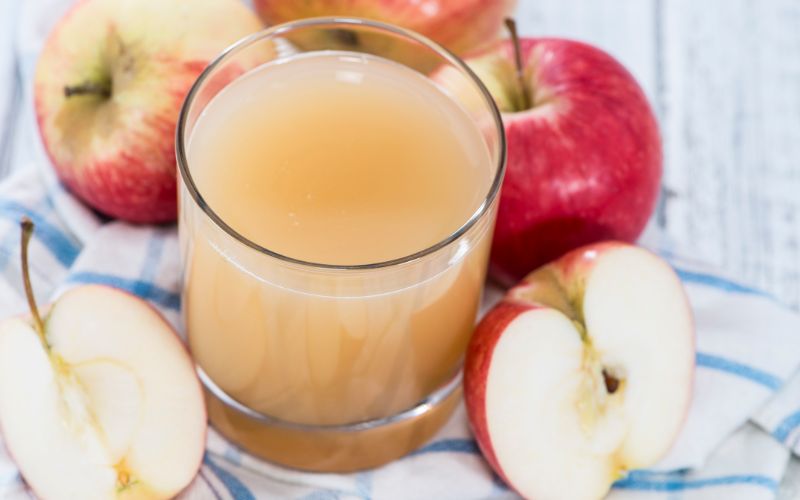Can I Drink Moldy Apple Juice (Must Know Things)
Last updated on October 26th, 2022 at 05:20 pm
Apple juice is one of the world’s most popular and consumed juices, just after orange juice.
It is because it has a lot of health benefits, as long as you take the sugar-free pack.
But like every other juice, apple juice has a limited shelf life and can get spoiled if not preserved well.
Moldy juice is not particularly dangerous to drink. Molds contain toxins called mycotoxins that can cause nausea, diarrhea, stomach aches, etc. However, taking one or two sips of moldy apple juice is not fatal, only if you consume too much.
What Happens When You Drink Moldy Apple Juice?

Stomach acids can kill only small amounts of pathogens. Therefore, a small quantity of moldy apple juice will not cause any health issues.
But taking plenty of it can cause vomiting, nausea, headaches, and stomach aches. So it’s not necessarily dangerous.
Molds contain a type of toxin called mycotoxins.
Mycotoxins cause health issues ranging from acute poisoning to long-term effects such as immune deficiency and cancer, according to WHO (Works Health Organization).
In collaboration with FAO, WHO is trying to curb mycotoxins intake worldwide, and one way is to dispose of foods with mold.
Apple juice with mold presence contains high amounts of patulin, a mycotoxin produced by molds like Aspergillus, Penicillium, and Byssochlamys.
Patulin is considered by WHO to be Genotoxic (toxins that affect the genes). And are also found by several researchers to be immunotoxic.
Molds can take days or years to show symptoms. Symptoms usually appear 2 to 9 hours after consumption and can last for a few days.
Symptoms include allergies like nasal stuffiness, throat irritation, skin and eye irritation, shortness of breath, cough, muscle ache, stomach ache, chills, fatigue, and weight loss.
Mold can compromise the immune system causing lethargy and sadness in affected people.
It can be hard to ascertain if mold exposure is responsible for specific illnesses.
It is in your best interest to stop assuming and visit your doctor for medical consultation and counseling.
What Does Mold in an Apple Juice Look Like?
Molds that grow on apple juice come in different shades of color; blue, white, gray, etc.
The most common molds have gray and white colors with dark spots. They are either fluffy, lumpy, or have a dusty texture.
What Kind of Mold Grows in Apple Juice?
Green and white are the most common types of molds that grow on Apple juice.
With time, white molds can change color to green, blue, gray, etc., but it’s still the same kind of mold.
White molds are not too common, but just like black molds, it has their effects on human health.
White mold thrives on moist surfaces, as juice is a suitable medium. Molds can grow in containers, even in the fridge, due to broken containers or open caps.
Penicillium expansum is the most common and destructive post-harvest problem of Apple.
It affects the tissues of the apple. Making use of harvested apples with penicillium contamination will produce mycotoxins that have adverse effects on our health.
A few types of Penicillium species are preservative resistant and can thrive in the presence of certain preservatives.
Some can resist temperature up to some level, except for freezing temperatures. This kind of mold can also grow on Apple juice.
Can You Get Sick from Drinking Old Apple Juice?
No. You won’t get sick from drinking old or expired juice.
Foods are safe to eat after their expiry date as long as they are under the right temperature, according to the US Department of Agriculture Food Safety and Inspection service.
Dates indicate quality, not safety.
You are more likely to get drunk than sick from drinking old or Moldy juice. The reason is that old juice will start fermenting and taste more like vinegar or alcohol.
The quality will reduce as it ferments and becomes intoxicating.
Fermented apple juice is harmless, and it is considered less potent compared to other alcohol.
Dates are just guidelines used to determine the last date a good item is of its best quality. It’s essential to follow these guidelines.
“Sell by” and, “use by,” dates tell you the time frame a food item is supposed to be off the shelf.
So, check for expiry dates if you want to buy any food item. But if you purchase expired apple juice, unknowingly check if it’s still good for consumption. If it is not, dispose of it immediately.
Once your juice is open, please keep it in a refrigerator; do not leave any liquid in the warm air.
Juice should be consumed between 2-3 weeks when opened. The quality of juice can decrease over time, even in a refrigerator.
Attacks from microorganisms can cause fermentation and change the color. Homemade apple juice does not subscribe to expiry dates.
So, except you put preservatives on them, do not drink them if it’s old. But if you put it in a tightly closed container and store it in a refrigerator, you can drink it even if it’s old.
How Do You Know If Apple Juice Has Gone Bad?
Your senses are the most reliable way to test if your apple juice has gone bad.
The most common signs of sour apple juice are discoloration, sour smell, and mold growth.
A sour smell is the first sign you will notice. Then the color starts changing as it ferments. Finally, the presence of mold is the last Indicator of spoilage.
The presence of microorganisms in apple juice will start the fermentation process.
Microorganisms can enter if apple juice is open to dry air. As the juice begins to ferment, it loses its glamor and aroma.
The Apple juice begins to smell like vinegar and becomes sour. You will notice bubbles on the apple juice, and the container will begin to swell. It can even burst open if the liquid is full.
You will also notice that the apple juice suddenly becomes darker. It is because discoloration starts simultaneously with fermentation.
Discoloration can come in different shades of color, and as stated earlier, our senses might not be the most reliable instruments, but they can be helpful to some extent.
If you have eye problems like color blindness, you might find it hard to see a color change.
Therefore, you can get someone to help you check or use another medium.
The presence of mold is the peak of bad apple juice. As it continues to ferment, you will notice fuzzy substances growing in the liquid. The growth of the mold will increase over time.
The presence of mold can be avoided if you preserve it well. If you buy any Apple juice, preserve it in the refrigerator. Change the container if you notice any holes.
Once you open the container, try to consume it within a few days. The quicker you drink it while it’s open, the more you avoid fermentation.
The table below shows how long apple juice can last.
| State of Apple Juice | Pantry | Fridge |
|---|---|---|
| Apple juice sold refrigerated (unopened) | 3 – 6 months | Best before the expiry date |
| Apple juice sold refrigerated (opened) | One day | 2-3 weeks |
| Apple juice sold refrigerated (unopened) | Best before the expiry date | 3-5 days |
| Apple juice sold refrigerated (opened) | Best before the expiry date | 7-10 days |
| Homemade Apple juice | Use it all the same day | 3-5 days |
The shelf life depends on the preservation method and whether the juice was pasteurized.
If it is pasteurized and preserved well, it can stay in its best quality for 7 to 10 days before it can start losing its quality.
Conclusion
Molds are toxic to human health, so you should avoid consuming them.
Instead, preserve your apple juice by keeping it in the refrigerator or freezer. If you notice any signs of spoilage, please trash the drink.






